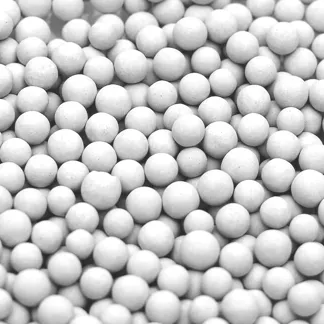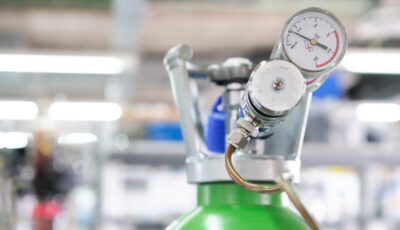Activated Alumina: Desiccants, Adsorbents, and Water Treatment
Activated alumina is a highly porous form of aluminum oxide that is commonly used as a desiccant to remove moisture from air and gases in various industrial processes. It is also utilized in the purification of liquids such as removing fluoride, arsenic, and other impurities from water.

What is Activated Alumina?
Activated alumina, known for its impressive surface area and adsorption capabilities, is a highly porous form of aluminum oxide. This material is created through the process of dehydroxylation of aluminum hydroxide, resulting in the production of a substance with exceptional porosity. The high surface area makes it an ideal choice for various applications, from water treatment to air purification and natural gas processing.
The unique physical structure of activated alumina allows it to effectively remove impurities, contaminants, and moisture from different substances. Its ability to attract and hold water and other liquids makes it an excellent desiccant, particularly for maintaining low levels of moisture in the air to prevent corrosion or spoilage of products. Due to its large surface area and numerous pores, activated alumina can efficiently adsorb water vapor, making it an indispensable material in industrial processes where moisture control is critical.
One of the most notable applications of activated alumina is in water treatment. By effectively removing fluoride and other dissolved impurities from water, it plays a crucial role in ensuring safe and clean drinking water. Its use in air purification systems is equally significant as it aids in capturing harmful gases or volatile organic compounds present in the air, contributing to improved indoor air quality.
For instance, in natural gas processing, activated alumina is utilized for drying compressed air and other gases by removing moisture content. Similarly, in the pharmaceutical industry, it plays a pivotal role in preserving the integrity of sensitive medications by controlling humidity levels during storage and transport.
Visitors to our website, Hengye Inc., can access comprehensive details about the manufacturing process, specifications, and various applications of activated alumina. This highly informative resource serves as a valuable guide for understanding the versatile uses of activated alumina across different industries.
Activated Alumina Adsorption Properties
When it comes to absorbing water and other impurities from various substances, few materials are as efficient and versatile as activated alumina. Its high surface area and porosity play a significant role in this success, granting it the ability to effectively remove impurities.
There’s something truly fascinating about the way activated alumina works – it can selectively adsorb molecules. Imagine this as a highly effective “sorting process.” It is capable of distinguishing between different types of molecules and choosing the ones that need to be removed. This selective adsorption makes it valuable for a wide range of applications across industries such as air separation, natural gas refining, petrochemicals, and industrial drying.
Activated Alumina’s High Surface Area
One of the most significant factors contributing to its exceptional adsorption properties is its high surface area. This microscopic terrain provides an extensive landscape for interaction with other compounds, allowing for effective adsorption. In practical terms, this means more impurities can be captured within a smaller amount of material – a truly impressive feat.
In addition, its unique porosity enhances its efficiency by providing ample room for gases or liquids to be captured or passed through.
When you consider the versatility of activated alumina in terms of adsorption, it’s clear why it’s considered such an invaluable material. With its ability to remove contaminants from air and fluids, it plays a crucial role in maintaining purity in various processes and applications.
So, whether it’s safeguarding the purity of air or enhancing the quality of petrochemicals—activated alumina stands out as an indispensable tool, offering unparalleled versatility and reliability.
The remarkable adsorption properties of activated alumina position it as an indispensable part of numerous industrial applications, proving to be both efficient and reliable in handling diverse challenges across multiple sectors.
Water Adsorption
Activated alumina stands as a go-to solution for treating drinking water due to its extraordinary water adsorption capabilities. Visualize it as a tiny sponge within your water system, eagerly soaking up impurities, particularly crucial when eliminating fluoride, arsenic, and selenium, which in large quantities can pose health risks.
When activated alumina becomes part of a water treatment process, it efficiently removes these impurities. Primarily functioning as a magnet that attracts and holds onto harmful substances, it prevents them from reaching our taps. These properties are attributed to the activated form of aluminum oxide it contains, offering an exceptionally large surface area for adsorption.
What makes this so effective is the fine structure within activated alumina: its numerous pores and channels exponentially increase the material’s surface area. This allows it to absorb a significant amount of water and harmful contaminants, making it an exceptional partner in addressing conditions caused by excess fluoride or arsenic uptake from drinking water.
In scenarios where public health is at stake, activated alumina filters are strategically placed in community water systems, further emphasizing their importance in water adsorption. Positioned to treat large volumes of water efficiently, they yield positive outcomes not only in potable water treatment but also in industrial wastewater treatment applications.
Oil and Gas Adsorption Using Activated Alumina
In the oil and gas industry, activated alumina is an essential tool for maintaining the purity and integrity of various streams. When it comes to purification and dehydration, this remarkable substance excels in removing impurities and moisture from hydrocarbon liquids and gases.
Purification: After crude oil extraction, it often contains impurities that need to be removed before it can be used for various applications. Activated alumina eliminates undesirable elements such as sulfur compounds, aromatics, and color bodies, significantly enhancing the quality of end products.
Dehydration: Moisture can cause corrosion and pipeline blockages in the oil and gas industry. Activated alumina acts as a powerful desiccant, efficiently removing water from hydrocarbon liquids and gases. By minimizing moisture content, it prevents the formation of hydrates, thus contributing to enhanced process efficiency and equipment reliability.
At Hengye Inc., there are dedicated resources and expertise catering to the specific needs of the oil and gas sector. The comprehensive offerings in activated alumina are tailored to meet stringent requirements of oil and gas applications.
The use of activated alumina is not limited to purification and dehydration; it also ensures operational efficiency within the industry. By maintaining product quality and protecting critical infrastructure from corrosion, its impact extends throughout multiple stages of production and transportation.
It also contributes to environmental sustainability by aiding in compliance with stringent regulations. Its ability to purify hydrocarbon streams supports efforts to reduce harmful emissions—making it an invaluable ally for achieving operational excellence while upholding environmental responsibility.
Consider the dehydration of natural gas—a critical process in gas processing plants. The precise control of moisture levels achieved through activated alumina desiccants is instrumental in preventing hydrate formation during transportation, safeguarding pipelines, compression equipment, and other components from potential damage caused by ice-like crystalline structures that may obstruct flow.
By leveraging the multifaceted capabilities of activated alumina, Hengye Inc. empowers the oil and gas industry to uphold the highest standards of product quality, safety, and environmental stewardship.
Dehydration and Drying Applications of Activated Alumina
Activated alumina serves a crucial function in industrial processes that necessitate the extraction of moisture from air, gases, and liquids. Whether preserving the freshness and crunch of potato chips or ensuring the longevity of products and equipment on an industrial scale, its significance is undeniable. The applications are manifold, spanning from compressed air drying to natural gas dehydration, and even the drying of solvents used in chemical manufacturing.
In industrial setups, it proves indispensable for steering clear of equipment damage caused by moisture in compressed air systems. Moisture generated during compressor operation is a potential source of corrosion and can adversely affect pneumatic tools and downstream equipment. By utilizing it for air drying, companies can maintain consistent product quality and prolong the life of their processing equipment. Similarly, for natural gas dehydration, activated alumina plays a vital role in removing water vapor and contaminants that could wreak havoc during transportation and storage, thereby preventing significant corrosion problems along gas pipelines.
The critical aspect here is that moisture can have catastrophic effects on products during production processes or while in storage.
Moisture’s detrimental impact on various processes is considerable; for example, in the petrochemical industry, catalytic reactions are delicately sensitive to moisture levels. Proper dehydration becomes essential for maintaining product quality and curtailing downtime due to water-related equipment failures.
Activated alumina’s efficacy lies within its ability to selectively adsorb water molecules while excluding other components within the system. It acts almost like a molecular sieve, capturing unwanted water vapor and shielding crucial components against degradation or failure as a result of excessive moisture content.
Should you require assistance navigating through the application of alumina in dehydration operations, we at Hengye Inc. provide comprehensive technical resources and product specifications. Our expertise extends beyond delivering top-tier products; we also offer valuable technical information and guidance to ensure optimal performance in specific processes.
Understanding the diverse roles activated alumina plays in dehydration and drying invites industries to make informed decisions that enrich operational efficiency while upholding the integrity of their products and equipment.
Water Removal With Activated Alumina
When it comes to removing impurities such as water, activated alumina stands out across various industrial settings. Its unique ability to effectively remove not only water but also other impurities makes it an indispensable component in water systems, air compression units, and different industrial processes.
Consider a manufacturing facility that produces sensitive equipment where excess water can lead to corrosion and product damage. Activated alumina works behind the scenes tirelessly, ensuring that the water content is at an optimal level, thereby safeguarding the integrity of the products.
Furthermore, across water treatment systems, activated alumina plays a crucial role in ensuring the purity of water by effectively removing impurities like fluoride, arsenic, and selenium. This is particularly beneficial in regions where water quality is a primary concern, providing communities with access to clean and safe drinking water.
Now envision a municipality investing in improving its water treatment infrastructure. Activated alumina would be a key ally in addressing impurities such as arsenic, safeguarding public health by ensuring access to clean and safe drinking water for residents.
In essence, activated alumina serves as a safeguard against the detrimental effects of water impurities, preserving the integrity of products and safeguarding the well-being of communities by ensuring access to safe drinking water.
Hengye Inc.’s website provides informative guidelines on how activated alumina can be effectively utilized for specific industrial applications and how it contributes to ensuring elevated standards of quality across diverse sectors.
Activated Alumina in Air Purification Industries
A critical component in maintaining a healthy indoor environment is ensuring the air is clean and fresh. Harmful airborne chemicals, allergens, and pollutants can lead to respiratory issues and other health concerns. Activated alumina becomes an essential solution in this regard.
One of its notable applications is in air purifiers, where its exceptional adsorption capabilities effectively capture and remove volatile organic compounds (VOCs), moisture, and other contaminants from the air. This makes it a top choice for keeping indoor environments safe and comfortable.
In heating, ventilation, and air conditioning (HVAC) systems, activated alumina contributes significantly to controlling humidity levels and capturing harmful particles such as dust and mold spores. By acting as an efficient desiccant to regulate moisture, it helps prevent the growth of mold and mildew while also enhancing the overall air quality within a building.
Moreover, in industrial air treatment processes, it’s versatility shines through by aiding in the purification of industrial emissions. It effectively adsorbs harmful gases and chemical vapors, thereby promoting cleaner air in industrial settings where pollutant control is critical.
This adaptable nature of activated alumina demonstrates its vitality across a wide spectrum of air purification applications.
For those seeking further insights into the impactful role of activated alumina in air purification industries, our website offers case studies and technical articles featuring real-world examples showcasing its effectiveness in maintaining superior air quality. These resources provide valuable knowledge and evidence-based information to support professionals in making informed decisions regarding air treatment solutions.
It is clear that activated alumina is not just a one-trick pony but instead an instrumental player when it comes to ensuring clean and healthy indoor air in various environments.
Looking to enhance indoor air quality? Contact us at Hengye Inc. for expert advice on utilizing activated alumina for air purification purposes. Call us at 844-308-3271.


